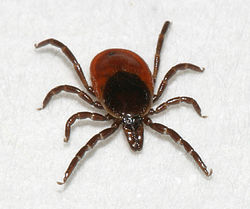Ixodes (genus)
| Literature database |
|---|
| 1585 articles sorted by: |
| • year (descending) |
| • research topics |
| • countries/regions |
| • list of natural enemies |
Ixodes Latreille 1795
This genus includes more than 200 species of ticks, with many of them being important disease vectors. Transmitted diseases are the Lyme disease as well as diseases caused by viruses, other species of Borrelia and by species of Babesia, Ehrlichia and Anaplasma. Common hosts are mammals, birds and lizards.
The ticks develop through 3 stages (larva, nymphs and adult stage) and must take a blood meal before passing to the next stage. Feeding is completed within a few days, after which the tick drops off the host, moults and must find another host to continue its development. Unfed adults are about 3-4 mm long. The cuticle has striations, eyes are absent, and the position of the anal groove is characteristic for the genus.
The following are the most important vector and pest species (for other species see list below),
in Europe and Asia:
in North America:
in Australia:
For other species see the list below.
Currently, the following species have been entered into the system:
- Ixodes acutitarsus
- Ixodes affinis
- Ixodes angustus
- Ixodes auritulus
- Ixodes brunneus
- Ixodes canisuga
- Ixodes cookei
- Ixodes cornuatus
- Ixodes cumulatimpunctatus
- Ixodes dentatus
- Ixodes frontalis
- Ixodes gibbosus
- Ixodes granulatus
- Ixodes hexagonus
- Ixodes holocyclus
- Ixodes jellisoni
- Ixodes kingi
- Ixodes loricatus
- Ixodes marxi
- Ixodes minor
- Ixodes monospinosus
- Ixodes muniensis
- Ixodes muris
- Ixodes nipponensis
- Ixodes ovatus
- Ixodes pacificus
- Ixodes pararicinus
- Ixodes pavlovskyi
- Ixodes persulcatus
- Ixodes redikorzevi
- Ixodes ricinus
- Ixodes rubicundus
- Ixodes scapularis
- Ixodes sinensis
- Ixodes spinipalpis
- Ixodes tanuki
- Ixodes texanus
- Ixodes trianguliceps
- Ixodes turdus
- Ixodes uriae
- Ixodes vespertilionis
- Ixodes woodi
